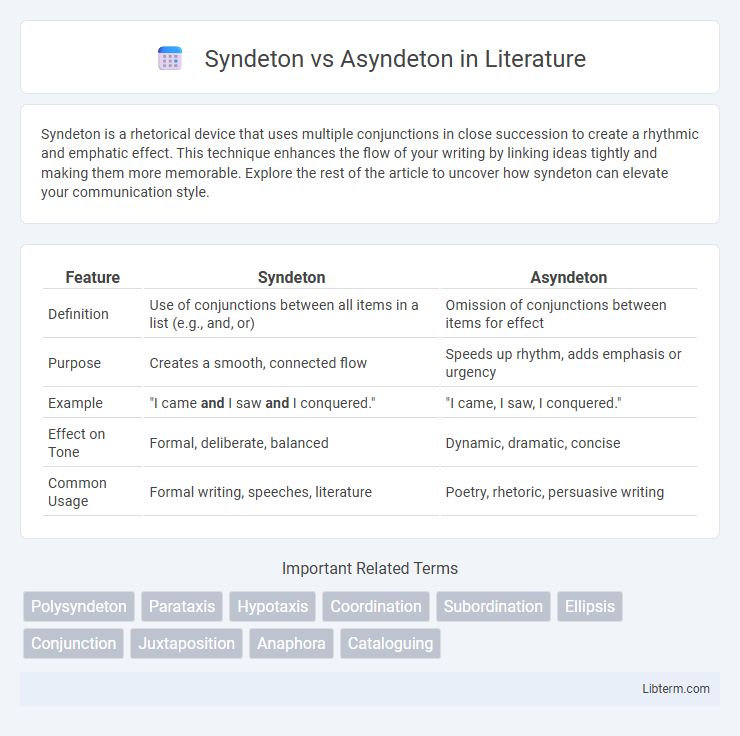Syndeton is a rhetorical device that uses multiple conjunctions in close succession to create a rhythmic and emphatic effect. This technique enhances the flow of your writing by linking ideas tightly and making them more memorable. Explore the rest of the article to uncover how syndeton can elevate your communication style.
Table of Comparison
| Feature | Syndeton | Asyndeton |
|---|---|---|
| Definition | Use of conjunctions between all items in a list (e.g., and, or) | Omission of conjunctions between items for effect |
| Purpose | Creates a smooth, connected flow | Speeds up rhythm, adds emphasis or urgency |
| Example | "I came and I saw and I conquered." | "I came, I saw, I conquered." |
| Effect on Tone | Formal, deliberate, balanced | Dynamic, dramatic, concise |
| Common Usage | Formal writing, speeches, literature | Poetry, rhetoric, persuasive writing |
Introduction to Syndeton and Asyndeton
Syndeton and asyndeton are rhetorical devices used to manipulate the presence of conjunctions within a sentence to affect its rhythm and emphasis. Syndeton involves the deliberate use of conjunctions like "and" or "but" to link clauses, creating a sense of continuity and cohesion. Asyndeton, in contrast, omits conjunctions between words or phrases, resulting in a concise, impactful expression that often conveys speed or urgency.
Defining Syndeton: Meaning and Usage
Syndeton is a rhetorical device characterized by the use of conjunctions, typically "and," to connect words, phrases, or clauses within a sentence, creating a deliberate and clear connection. This technique enhances readability and emphasizes the relationship between connected elements, often producing a rhythmic and cohesive flow in writing or speech. Writers employ syndeton to maintain clarity and emphasize unity among listed items or ideas, contrasting with asyndeton, which omits conjunctions to create a more rapid or impactful effect.
Understanding Asyndeton: Meaning and Functions
Asyndeton is a literary device characterized by the intentional omission of conjunctions between words, phrases, or clauses to create a concise, impactful expression. Its primary functions include enhancing the rhythm, speed, and emotional intensity of a sentence while emphasizing the individual elements listed. Famous examples, such as Julius Caesar's "I came, I saw, I conquered," demonstrate how asyndeton can produce a memorable and persuasive effect in both speech and writing.
Key Differences Between Syndeton and Asyndeton
Syndeton employs coordinating conjunctions like "and" or "but" to connect phrases or clauses, creating a rhythm and clarity in sentences. Asyndeton omits these conjunctions, resulting in a faster-paced, more dramatic effect by listing elements without connectors. The key difference lies in syndeton's use of conjunctions for explicit links, while asyndeton relies on the absence of conjunctions to enhance impact and brevity.
Linguistic Effects of Syndeton
Syndeton employs the deliberate use of conjunctions like "and" or "or" between words, phrases, or clauses to create a rhythm that enhances clarity and cohesion in sentences. This linguistic device emphasizes each element equally, promoting a sense of accumulation and deliberate pacing that can intensify the emotional impact or importance of the listed items. By contrast to asyndeton, syndeton's structured linkage supports smooth readability and reinforces logical relationships within the text.
Rhetorical Impact of Asyndeton
Asyndeton enhances rhetorical impact by omitting conjunctions between words, phrases, or clauses, creating a rapid, concise, and impactful rhythm. This technique intensifies emotions, emphasizes urgency, and generates dramatic effect by accelerating the pace of the sentence. Compared to syndeton's balanced and connected flow, asyndeton delivers a more forceful, memorable impression in speeches and literary works.
Common Examples in Literature
Syndeton frequently appears in literature through coordinated lists using conjunctions like "and" or "or," exemplified by Charles Dickens' phrase, "He was brave and honest and kind," emphasizing completeness and rhythm. Asyndeton, characterized by the deliberate omission of conjunctions, is found in Julius Caesar's famous line, "I came, I saw, I conquered," which creates a rapid, dramatic effect by speeding up the cadence. Both devices shape narrative pacing and tone, with syndeton providing clarity and balance, while asyndeton intensifies emotion and urgency in literary works.
Usage in Everyday Language
Syndeton and asyndeton differ in their use of conjunctions to connect words or phrases, with syndeton employing conjunctions like "and" or "but," while asyndeton intentionally omits them for a faster rhythm. In everyday language, syndeton is more common for creating clear, straightforward sentences that guide the listener or reader through ideas, such as "I bought apples and oranges and bananas." Asyndeton appears frequently in speech or writing meant to convey urgency or emphasis, exemplified by phrases like "I came, I saw, I conquered," where the omission of conjunctions accelerates the delivery and impact.
Benefits and Drawbacks of Each Technique
Syndeton enhances clarity and flow by using conjunctions, making sentences easier to understand and adding rhythm, but it can become repetitive or overly long. Asyndeton creates a sense of urgency and impact through omission of conjunctions, leading to concise and powerful expressions, though it may risk confusion or abruptness if overused. Both techniques serve distinct stylistic purposes, with syndeton favoring smoothness and asyndeton emphasizing intensity and speed.
Choosing Between Syndeton and Asyndeton
Choosing between syndeton and asyndeton depends on the desired rhetorical effect and pacing in writing or speech. Syndeton, which uses conjunctions like "and" or "but," creates a balanced and rhythmic flow, enhancing clarity and cohesion. Asyndeton omits conjunctions to produce a faster, more dynamic rhythm that emphasizes urgency or intensity.
Syndeton Infographic

 libterm.com
libterm.com